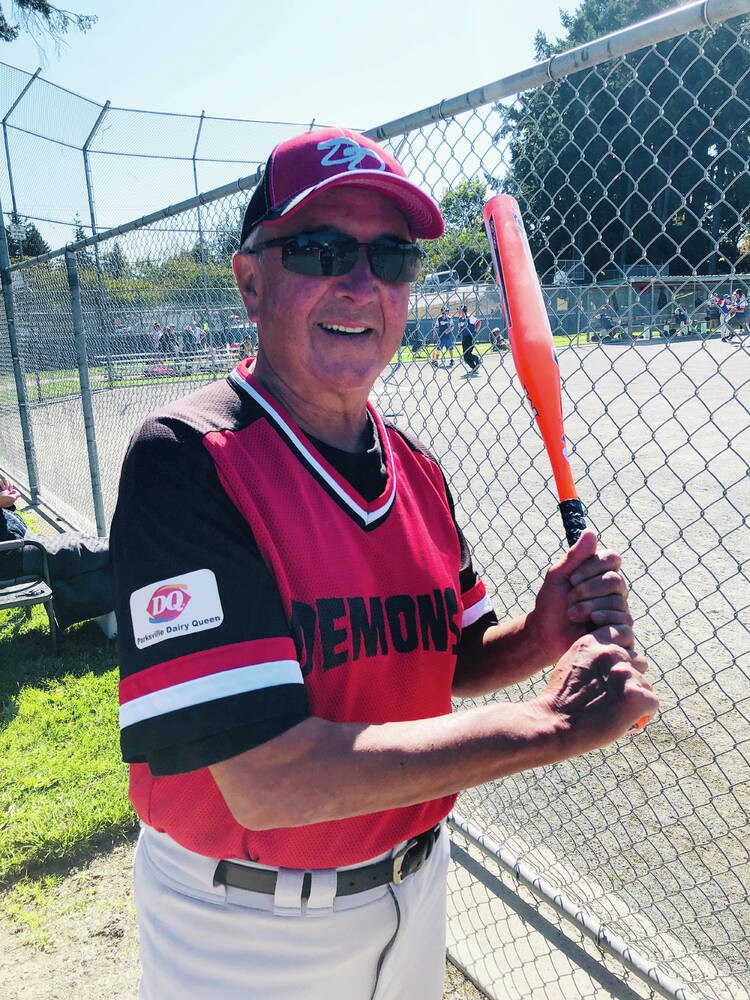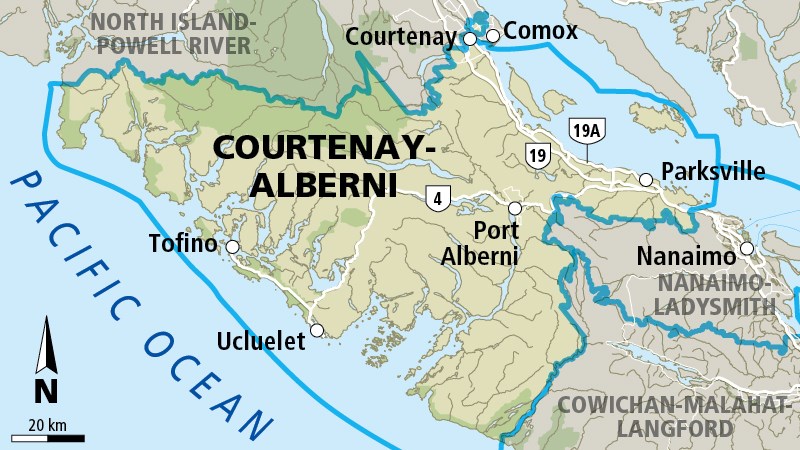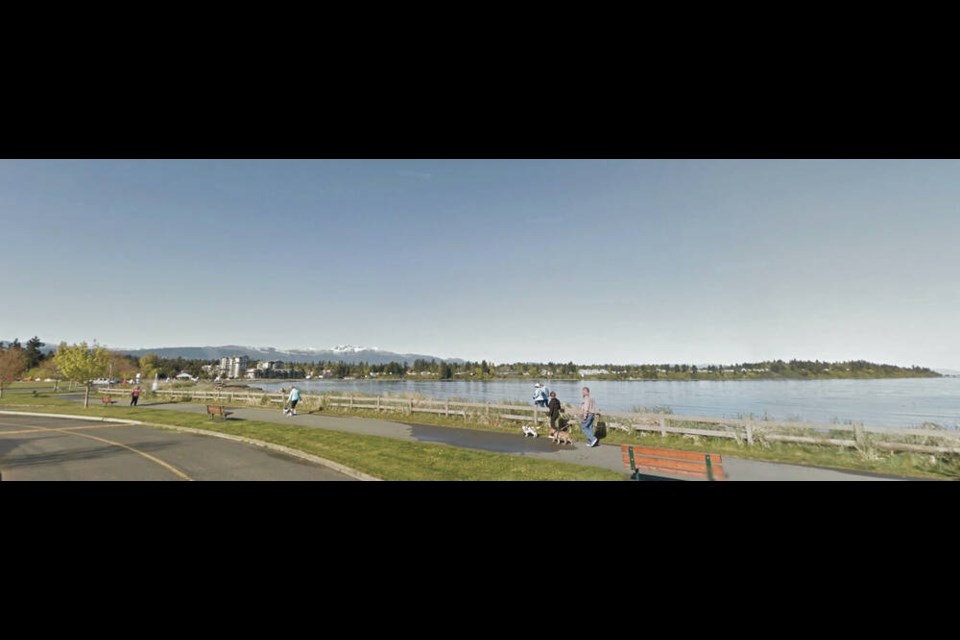Jack Knox is dropping in on 91ԭ�� Island’s seven federal ridings, looking at them through the lens of issues readers say are important in this election.
“May 1, I had a heart attack,” says Nick Pross, leaning against the ball field dugout in Parksville’s bustling and beautiful waterfront park.
He had no warning, no symptoms. One moment he was fine, and next thing the 74-year-old Qualicum Beach man knew, he was in the care of the cardiac wizards at Victoria’s Royal Jubilee Hospital. Five bypasses.
But look at Pross now. Cycling, back to golfing 18 holes. He’s almost ready to go from coach to player on the slo-pitch team whose players are on the field on this warm September morning.
“I can’t sprint. I can’t steal bases. I’ve still got cement shoes,” the retired fraud investigator says, “but I’m faster than some of those here.”
His isn’t a rare story, not in this crowd. Other players have pacemakers, artificial hips, new knees. This ball field has more titanium than an aircraft plant.
The whole over-55 league — 11 teams, 150 players — is like that, dotted with grey-hairs who are active despite (or, to be precise, because of) such interventions.
And slo-pitch is just one of the sports under the Parksville Golden Oldies Sports Association umbrella: pickleball, volleyball, curling…. The association has about 1,000 members, most between ages 55 and 80, but 100 older than that.
Let’s talk health care.
It’s one of the issues readers told us they wanted the Times 91ԭ�� to focus on in this campaign, and it’s certainly a big deal in Courtenay-Alberni, where most residents — at least on the east side of the riding — are old enough to tell you where they were when Paul Henderson scored.
At 50.4 years, the median age in Courtenay is nine years older than it is in Canada as a whole. In Parksville the figure is 62.2. And Parksville is positively peach-fuzzy compared with Qualicum Beach, where the median age of 65.9 is the oldest in Canada.
It’s a different demographic on the other side of The Hump, the steep, twisting stretch of Highway 4 that climbs up and over the spine of 91ԭ�� Island, the divide that separates the golf carts of Oceanside from the pickup trucks of Port Alberni and the Westfalias-with-surfboards of Tofino.
But yes, if you ask people on the Strait of Georgia side what election issues matter to them, health and seniors care invariably make the list.

“We need doctors, doctors, doctors,” says Carolyn Carr, stopped on the street in Qualicum Beach. “And nurses,” adds fellow dog-walker Faye Way. There’s a shortage of both.
They’re echoed by octogenarian Frank Bukovac, in the parking lot of Courtenay’s London Drugs. “I’m bothered that there are so many people without a family doctor.”
At the ball game in Parksville, a pair of spectators spoke of the way COVID exposed the shabby treatment of the elderly (“the ones who built this society”) in some long-term care homes. It bugged them that people shrugged off residents’ deaths, as well as the isolation of their final days, as though their lives had less value.
Nanoose’s David Aitken also mentioned the care homes, particularly those in Quebec and Ontario. “The record is totally dismal on that front.”
Now, strictly speaking, health care is a provincial government responsibility, not a federal one. Ottawa’s main role is to transfer tens of billions of dollars to the provinces, with conditions attached on how it might be spent, the main one being that health care should be universal. But it would be a pretty dumb federal election candidate who responded to questions about doctor shortages or drug costs or the state of long-term care homes by saying “That’s Horgan’s problem.” So, what we get instead are federal politicians promising to funnel more money to the provinces for particular purposes. Among the party’s promises:
• Liberals: Cut wait times and hire 7,500 family doctors and nurses. Use student-loan forgiveness and tax incentives to attract health professionals to rural communities, and increase use of virtual care. Raise guaranteed income supplement for low-income seniors by $500 for singles and $750 for couples. Improve long-term care by training 50,000 more care aides and setting a $25-an-hour minimum wage for them. Expand mental health care. Universal pharmacare is still on the table.
• Conservatives: Increase health transfers to provinces by six per cent a year, a total of $60 billion over a decade. Tie federal funding to more mental health services, and add a tax incentive for employers who add mental health to employee coverage. Fund 1,000 residential drug-treatment beds. No national pharmacare, but would negotiate with drug companies to cut costs
• NDP: $10 billion a year for single-payer pharmacare. Extend medicare coverage to mental health and dental care. Abolish for-profit long-term care homes. Make protecting pensions a priority when companies go bankrupt. Reduce wait times.
• Greens: Universal pharmacare and more mental-health funding. Move seniors care under the Canada Health Act and abolish for-profit long-term care.
All this leads to another common concern on the streets of Courtenay-Alberni: government spending.
Nanoose’s Aitken put it succinctly: He’d like to vote for someone who can lead us through the COVID crisis, but who can also figure how to pay off the debt we’re running up doing so. “They’re the ugly twins of issues.”
Courtenay’s Bukovac was also worried. “The government is throwing money at everything. Our kids are going to have to pay and pay.”
The spending, particularly on COVID unemployment benefits, also bothered Port Alberni’s Corey Bourke. “They’re handing money out to people who don’t want to go to work while other people are screaming for employees.” The 40-year-old lost his job when the mill he worked at closed last year, so he found one in aviation.
For dog-walkers Way and Carr, affordable housing tops Qualicum’s list of needs. New homes go up with wealthier buyers in mind, not wage slaves. Government incentives to build rental housing are lacking.
“Employees can’t afford to live here,” Carr says. Service-industry workers have to commute. Either that, or they choose to work elsewhere: Restaurants are reducing hours due to lack of staff. Good luck finding somewhere to eat on Monday nights.
Seeking election to deal with all this are six candidates, including the NDP’s Gord Johns, who has been MP since 2015. He is known for work on the environment, including collaborating with Liberals to reduce marine plastic pollution. The challengers are Conservative Mary Lee, a communications professional and former major in the 91ԭ�� Armed Forces; Liberal Susan Farlinger, a retired senior public servant; environmental activist Susanne Lawson for the Greens; Denman Island’s Robert Eppich for the People’s Party; and Barbara Biley for the Marxist-Leninists.

THE RIDING
Courtenay-Alberni was a new riding in the 2015 election. It includes Port Alberni, Parksville, Qualicum Beach, Tofino, Ucluelet and Courtenay.
• Size: 8,571 square kilometres
• Population: 114,647
• Electors on list : 104,961
• In the past: New Democrat MP Gord Johns, a former Tofino councillor, won the seat with 41 per cent of the vote in 2019. The Conservative candidate was second with 33 per cent, followed by the Greens with 13 and the Liberals with 12.
THE CANDIDATES
• Gord Johns, NDP, incumbent MP since 2015
Website: reelectgord.ca
Facebook: @GordJohnsNDP
Twitter: @GordJohns
• Mary Lee, Conservative
A communications professional and former major in the 91ԭ�� Armed Forces
Website: maryleecpc.ca
Twitter: @CPC_HQ
Facebook: @maryleecpc
Instagram: marylee.cpc
• Susan Farlinger, Liberal
Formerly a DFO biologist and manager and Canada’s lead negotiator at the 91ԭ�� Salmon Commission
Website: susanfarlinger.liberal.ca
• Robert Eppich
Denman Island resident who managed a communications department before becoming a software developer
Website: roberteppich.ca
• Susanne Lawson, Green Party
Barbara Biley, Marxist-Leninist
Website: cpcml.ca



